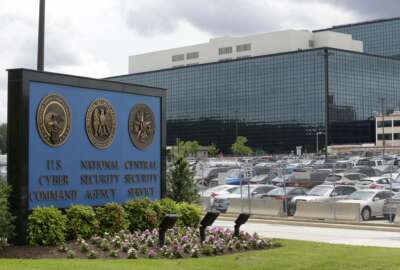Hubbard Radio Washington DC, LLC. All rights reserved. This website is not intended for users located within the European Economic Area.
VanRoekel offers silver lining in HealthCare.gov debacle
In his first public comments since the portal launched, federal CIO Steve VanRoekel said agencies and contractors can learn from the problems the website encoun...
wfedstaff | April 17, 2015 5:44 pm
WILLIAMSBURG, Va.–The Obama administration’s initial roll out of HealthCare.gov exemplified many of the long-standing problems with federal technology and procurement. But a senior White House official is trying to paint a silver lining around the fiasco.
Federal Chief Information Officer Steven VanRoekel said, like many other federal IT and acquisition breakdowns, there is a teachable moment that could, in the long term, make the government better.
“It’s where those things that I’ve been preaching, that many of you carry forward into the federal sphere have been preaching around the necessity to change, the necessity to evolve were sort of realized in some ways and not in others,” VanRoekel said during the Executive Leadership Conference sponsored by ACT-IAC Tuesday.
He said HealthCare.gov has to teach the federal IT community to look at projects differently and strive for continuous improvements.
“The overarching themes of federal IT that I’ve been talking about for the last few years have been a lot about how do you build systems that are more modular, that lower the risk surface, that engage new technologies and things like that,” VanRoekel said. “There are aspects of government that makes it hard to move at the speed in which you’d like to move, procurement, and the way we implement technology. We need to look at those things in this context as a teachable moment and think about how we can continue to evolve and drive these systems forward.”
Government’s boldness
He added he would work with the Office of Federal Procurement Policy on ways to improve federal IT procurement, but offered no specific ideas or areas of focus.
This is his first public comment by any senior technology official since the site launched with a lot of problems on Oct. 1. In fact before Tuesday, VanRoekel hadn’t spoken publicly in seven months as he was the acting deputy director for management at the Office of Management and Budget. The Senate confirmed Beth Cobert to be DDM last week.
VanRoekel also offered few details about OMB’s role in oversight or the actual problems or solutions, instead referring all questions to the Department of Health and Human Services.
House Oversight and Government Reform Committee Chairman Darrell Issa (R-Calif.) asked VanRoekel and federal Chief Technology Officer Todd Park for information and a briefing last week on their oversight over the HealthCare.gov portal. Issa gave the White House until Oct. 28 to schedule a briefing about OMB’s oversight role. An email to the committee asking if OMB met the Oct. 28 deadline was not answered.
VanRoekel said HealthCare.gov — even with all its warts — is an example of the government’s boldness.
“We should all be proud of the fact that something this complex, this integrated to legacy systems — and there are mainframes out there that this thing hooks to — was done at Internet scale and take online in this way,” he said. “Just the fact that we have transactions moving between agencies using open data, using modular development, using technology in a way that moves from a 19th and 20th century government paper approach to an online approach is something we all should be proud of in the federal IT community. And thinking about that boldness is key to where we go forward.”
While VanRoekel offered no details on how the Department of Health and Human Services is fixing the site, the agency posted a blog update Tuesday on progress in fixing HealthCare.gov.
Version 1.0 often struggles
It said the portal can process nearly 17,000 account registrants per hour — or five per second — with an error rate near zero.
Among the fixes HHS made recently are replacing a virtual database with a high- capacity physical one, which allows more efficient, effective processing and significantly reduced the error rate, or account registration failures, optimizing software configurations to increase efficiency in system interactions and adding capacity by doubling the number of servers.
HHS also said it pushed through a patch release with four software fixes to address users that were having a hard time logging in to their accounts.
VanRoekel said a complex website like HealthCare.gov will have problems, especially in version 1.0.
“My many, almost two decades at Microsoft, I shipped products that had similar issues. I had to recall a product once that I sold into the partner community, but not through to the customer yet,” he said. “But it was a lesson learned for me on what we needed to do to get the technology right at the end of the day. So even in large multinational companies this stuff happens, and I think the key there is what you take from this. Is this a teachable moment? Are you learning? Are you taking that learning and focusing on some key stuff?”
The top priority is to make HealthCare.gov work well and meet expectations.
But aside from that, VanRoekel said what can the federal IT community take from this so agencies and contractors don’t make the same mistake again in the future.
“It’s often notable risk taking or notable failures that often teach us how to do things differently in the future,” he said.
VanRoekel said one of those well known examples of a failure that produced needed change came about when the Veterans Affairs Department in 2006 lost a laptop containing the data of 26 million veterans. He said that led to needed changes around cybersecurity and for more CIO authorities.
One more priority for 2014
Aside from HealthCare.gov, VanRoekel offered insight into his 2014 priorities.
He said the workforce is becoming a fourth priority to go with innovate, deliver and protect.
Agencies always will need to attract talent and train workers, but a third focus area is redeployment, which is a bi-product of the other three priorities.
“Redeploying is about, as we drive efficiency into government, you suddenly take an agency from 20 email systems to one, you will have a lot of email administrators out there,” he said. “On the redeploying and reskilling standpoint, we need to think thoughtfully not only on the cut part of the equation on driving those costs down, but how are we investing in our people and training them to be redeployed to do more meaningful work inside the agencies.”
VanRoekel said OMB still is developing its plans and ideas of what can be done to improve and increase the skills of IT workers. He said things such as market pay for specific skills are hard to justify, as there are many areas that could qualify.
Another priority VanRoekel highlighted is the expansion of the innovate priority to include effectiveness.
It’s the idea of how agencies are serving their customers better and then taking what’s working at one agency and expanding it across others.
VanRoekel also addressed the role of the CIO without specifically calling out the potential changes under the Federal IT Acquisition Reform Act (FITARA).
The bill would require agencies to have only one person with the title CIO, and give that person more authority over commodity IT spending.
The Obama administration’s support for FITARA has been lukewarm.
Bureau CIOs need to focus on mission
He said the current setup of a headquarters CIO and bureau level CIOs has many problems, the biggest of which is a lack central coordination.
VanRoekel said too often the bureau level CIOs are too focused on the everyday technology such as email or mobile platforms and not focused on mission critical technology.
“The way this needs to change is headquarters needs to own what I will call commodity…services that are pretty common across many entities like email and mobile contracts,” he said. “The headquarters really needs to be the centerpiece for cyber technology and specify what cyber is out there. They then need to set up a services oriented infrastructure.”
The infrastructure provides bureaus with test and development or hosting or other types of services to make ideas come to fruition more quickly and easily because they are dependent on pre-determined standards.
“It lets the edge of the network think about mission every single day, and that’s important,” VanRoekel said. “It will really yield the results we want to see in government.”
VanRoekel summed up priorities with a call to action to industry and agencies alike: Help create a culture of excellence, a culture of continuous improvement and do things differently than in the past.
RELATED STORIES:
House Republicans press OMB for details on its oversight of HealthCare.gov
VanRoekel signals tepid support for Federal IT Acquisition Reform Act
Obama’s second term management agenda to focus on people power
Copyright © 2024 Federal News Network. All rights reserved. This website is not intended for users located within the European Economic Area.




